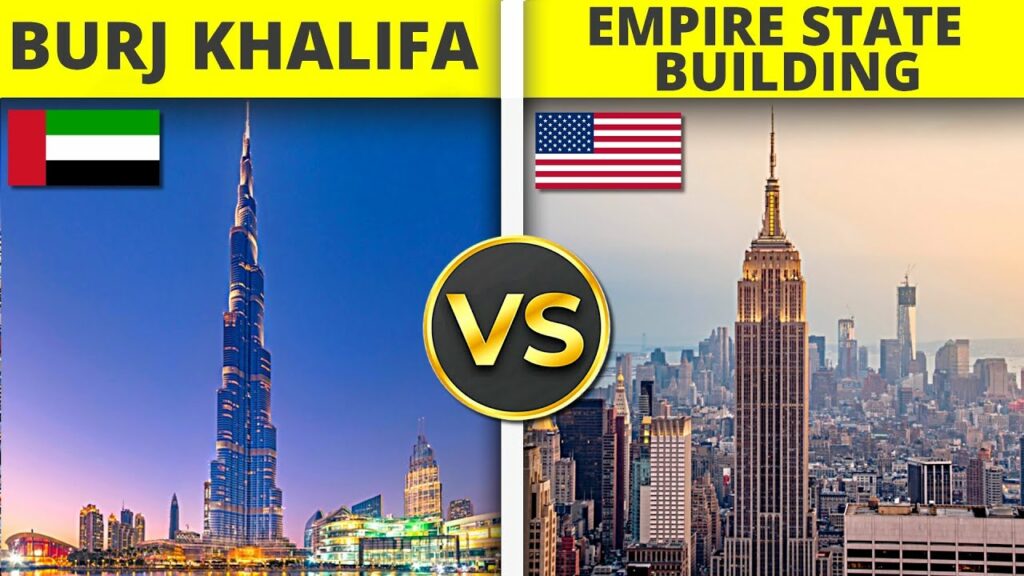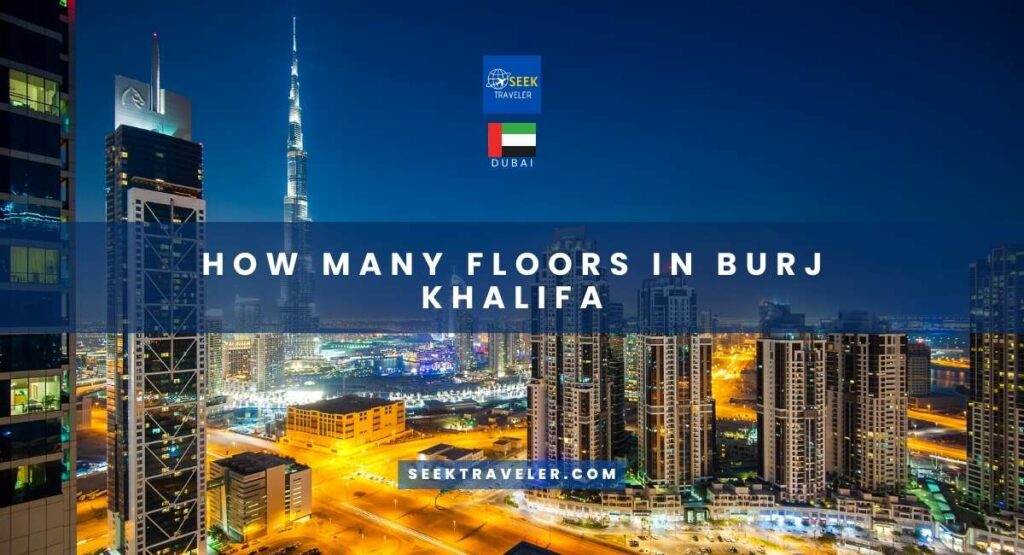When it comes to iconic skyscrapers, few come close to the Burj Khalifa and Empire State Building. These towering structures have become symbols of their respective cities and are among the most visited tourist attractions in the world.
As someone who has been fortunate enough to visit both buildings, I can attest to their grandeur and magnificence.
Standing at an impressive height of 828 meters (2,717 feet), the Burj Khalifa is currently the tallest building in the world. Its sleek design and modern architecture make it a true marvel of engineering.
On the other hand, the Empire State Building stands tall at 443 meters (1,454 feet) and boasts a distinctive Art Deco style that defines its place in history.
While both buildings share a common purpose – to reach new heights – they are vastly different in many ways. In this article, we’ll take a closer look at some of these differences and compare these two architectural wonders side by side.
Overview of the Burj Khalifa and Empire State Building
Get ready to compare two iconic structures, one towering over the New York skyline and the other piercing through the clouds of Dubai.
The Empire State Building, standing at 1,454 feet tall with 102 floors, was completed in 1931 and was once known as the tallest building in the world. On the other hand, Burj Khalifa is currently holding the title of being the world’s tallest building since its completion in 2010 with a height of 2,717 feet and a total of 163 floors.
The Burj Khalifa and Empire State Building may have contrasting heights and ages but they both play significant roles in their respective cities’ architecture and cultural identity. Both buildings have been featured in countless movies, TV shows, music videos, photographs and postcards. Their designs are unique yet timeless that it has become impossible to imagine their cities without them.
Now let’s delve deeper into these structures by examining their design and architecture.
Design and Architecture
When it comes to design and architecture, the Burj Khalifa and Empire State Building are two impressive structures that showcase different styles.
The modern engineering and innovative design of the Burj Khalifa make it stand out as a symbol of the future, while the classic Art Deco style of the Empire State Building represents a bygone era.
As I delve deeper into these contrasting architectural styles, I’ll explore how they reflect their respective time periods.
Modern engineering and design of the Burj Khalifa
You’re admiring the sleek and modern engineering of the tallest skyscraper in the world, marveling at how its design seamlessly integrates form and function.
The Burj Khalifa’s unique Y-shaped structure was specifically designed to maximize stability and minimize wind forces on the building. Its exterior is made up of high-performance glass panels that act as a sunscreen, reflecting heat away from the building while allowing natural light to shine through.
But it’s not just about functionality – the Burj Khalifa’s design also incorporates elements of Islamic architecture, such as its spiraling minaret-like structure that tapers as it reaches towards the sky. And let’s not forget about its stunning observation deck on the 148th floor, offering unparalleled views of Dubai and beyond.
With all these impressive features, it’s no wonder why the Burj Khalifa has become an iconic symbol of modern engineering and design.
Speaking of iconic symbols, let’s take a step back in time to admire another architectural masterpiece – but this time in a completely different style.
The classic art deco style of the Empire State Building is a stark contrast to the sleek lines of the Burj Khalifa, yet both buildings stand out for their unique contributions to the world of architecture.
Classic Art Deco style of the Empire State Building
You can’t help but admire the stunningly ornate and glamorous style of the towering masterpiece before you, with its iconic design harkening back to a bygone era of glamour and sophistication.
The Empire State Building’s Art Deco architectural style is truly a sight to behold, with its impressive height at 1,454 feet only adding to its grandeur.
Completed in 1931, the building was designed by Gregory Johnson and William F. Lamb of Shreve, Lamb & Harmon Associates.
Its distinctive features include its triangular shape at the top, intricate limestone detailing on the façade, and striking lobby adorned with marble walls and gold leaf finishes.
It’s no wonder that the building has become an American icon and one of New York City’s most recognizable landmarks.
Height and Observation Decks
The height and observation decks of these two iconic structures differ greatly. The Empire State Building stands at 1,454 feet tall and boasts two observation decks – one on the 86th floor and another on the 102nd floor. The main deck on the 86th floor offers incredible panoramic views of New York City, while the top deck provides a more expansive view that reaches as far as five different states on a clear day. However, visitors must pay an additional fee to access the top deck.
In contrast, Burj Khalifa is currently the tallest building in the world at a staggering height of 2,717 feet. It has three observation decks – one on the 124th floor, another on the 125th floor, and a third ‘At The Top SKY’ experience located on level 148. Each level offers unique views of Dubai’s skyline and surrounding desert landscape. Visitors can also enjoy interactive exhibits that showcase interesting facts about Burj Khalifa’s construction process and design.
Overall, both buildings offer exceptional observation experiences that are not to be missed when visiting their respective cities.
As we move into discussing their cultural significance, it’s important to note how these structures have become symbols not just for their cities but for human innovation and achievement as well.
Cultural Significance
This section delves into the cultural impact of these towering structures, highlighting how they’ve become symbols of human ingenuity and progress that inspire awe and wonder in all who behold them.
The Burj Khalifa and the Empire State Building are more than just buildings; they represent the aspirations of their respective eras.
The Empire State Building was completed during the Great Depression era, when America needed a symbol of hope to lift its spirits. Today, it remains an icon of New York City and American culture.
Similarly, the Burj Khalifa represents Dubai’s ambition to be a global city that attracts tourists and businesses from around the world. Its construction marked a turning point for Dubai’s economy as it shifted from oil to tourism.
Both buildings also serve as tourist attractions with observation decks that offer breathtaking views of their host cities.
With this in mind, it’s clear why both structures continue to capture our imagination even after decades since their completion.
As we look towards the future, sustainability will play an increasingly important role in shaping architectural design and city planning worldwide.
Sustainability and Future Plans
Looking ahead, architects and city planners must prioritize sustainability in construction to ensure a more environmentally conscious future. This is particularly important considering the scale of structures like the Burj Khalifa and Empire State Building.
The Burj Khalifa has made strides towards sustainability by incorporating features such as a condensate recovery system, reflective glazing, and energy-efficient lighting. Similarly, the Empire State Building underwent a retrofitting project that included upgrading its insulation, HVAC system, and windows to improve energy efficiency.
However, there is still much room for improvement in terms of sustainable design for skyscrapers. One potential solution is the implementation of green roofs or vertical gardens which can help reduce heat absorption and improve air quality. Additionally, incorporating renewable energy sources such as solar panels or wind turbines can greatly reduce a building’s carbon footprint.
As cities continue to grow upward rather than outward, it’s imperative that we consider the long-term environmental impact of these towering structures and make conscious efforts towards designing them with sustainability in mind.
Conclusion
In conclusion, the Burj Khalifa and Empire State Building are two of the most iconic structures in the world. Each building has its unique design, architecture, and cultural significance that sets them apart from each other.
The Burj Khalifa stands tall as a symbol of modernity while the Empire State Building represents a bygone era of American history. While both buildings offer observation decks with stunning views, the Burj Khalifa’s height and technological advancements make it a marvel to behold. Additionally, its commitment to sustainability through initiatives like solar panels and water recycling showcases its dedication to creating a better future for all.
Overall, both buildings have left an indelible mark on their respective cities and continue to inspire awe in visitors from all over the world. Using parallelism in this conclusion adds a level of sophistication to the writing by emphasizing the similarities and differences between these iconic structures. This style allows for an analytical approach while remaining objective in evaluating both buildings’ features.
Ultimately, whether you prefer towering heights or historical charm, both buildings offer something worth experiencing firsthand.

Meet Scott Robinson, a seasoned traveler with 28 countries under his belt, has immersed himself in diverse cultures around the world. His articles are a window into the rich tapestry of traditions, customs, and local flavors he has encountered on his globetrotting escapades. Scott’s deep appreciation for the beauty of cultural diversity shines through his writing, allowing you to embark on a virtual journey that celebrates the vibrant mosaic of humanity.



